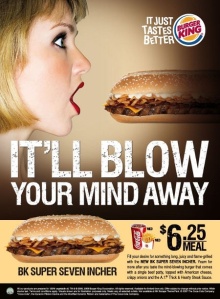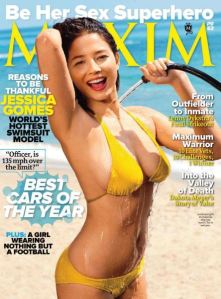This ad just drives me crazy! I think it is pretty self-explanatory and the sexual connotation is more than obviously portrayed. Let’s start from top to bottom. First of all, the girl’s facial expression of astonishment with her mouth open not only represents an absurd image of her been submissive to a burger, but what is most upsetting for me is that the burger is a phallic illustration of the male genital (penis), thus, making it seem as if she was giving ‘the burger,’ what we could properly called a fellatio (blow job). How messed up is this!! Along the image, the messages “It just tastes better,” “It’ll blow your mind away,” or “BK Super Seven Incher” in the ad only reinforced the phallic symbolism of the burger. This ad is definitely offensive and derogatory to women by portraying a woman who appears to be submissive, vulnerable and defenseless to a burger, which is a clear representation of masculinity and male dominance over women. It is surprising to find out that even fast food ads can communicate sexist and discriminatory messages against women. This ad is a pornographic fantasy that targets to satisfy men’s pleasure through the sexualization of women. Therefore, this ad is a clear example of how pop culture and mass media’s main concern is to satisfy a patriarchal, male society in which women are been underrepresented and undermined.
This image was the cover photo of Maxim magazine on November 2011. Although November is not the best month of the year to wear a bikini and go to the beach, swimsuit model Jessica Gomes seems to be having a great time while watering herself with a hose, object that is used in this photograph as a phallic symbol of the male organ (penis). Since Maxim is a magazine intended to target the attention of men, it is not surprising that the female model is used to create a pornographic fantasy for the audience. With messages in the ad such as “Be her sex hero,” the magazine invites the reader to buy the magazine as the reader is guaranteed to find more photographs of Gomes wearing bikini, or probably even naked, inside the magazine. Therefore, this cover photo is a clear representation of the sexual objectification of women for the only purpose of satisfying men’s fantasies. I really doubt that in this photo Gomes is having the opportunity to enjoy her sexuality, but instead I see this photo as an extremely damaging image that helps to perpetuate women subordination and objectification through the power of the male gaze. Gomes’ body position and facial expression makes it really obvious that she should be getting watched by men. Therefore, as a swimsuit model Gomes falls under the phrase “men act and women appear,” by which she has learned to look at herself the way a man would be looking at her in the photo. Therefore, Gomes has seen to have internalized this self-objectification as part of her role in society.
When thinking of my worst memory of women in pop culture, so many female artists and music videos come to mind, such as Britney Spears, Christina Aguilera, Rihanna, etc. These are artists who have had a significant influence on young people throughout the world, especially young women. One of the worst music videos I remember watching was Jessica Simpson’s “These Boots Are Made for Walking” from the movie “The Dukes of Hazzard.” In this music video Simpson is the object of attention as she portrays this country, promiscuous girl who dances in front of every man who stares or flirts at her because of her provocative outfit and movements. Even part of the lyrics to the song say, “Now your looking right where I thought you’d be looking.” When I thought of this provocative, promiscuous attitude that she carries throughout the video, the first idea that came to my mind is that if she had been raped by one of the man at the bar, the man would have argued in his defense that “she was asking for it.” Is this really the message Simpson is trying to convey? The worst part of the video is when Simpson is washing a car wearing a bikini, thus, creating a pornographic fantasy for men as she is self-objectifying herself as a symbol of desire and pleasure. I definitely think this scene is completely irrelevant to the music video and only reflects the internalized oppression of women. Even though the video tries to portrayed Simpson as a ‘powerful, independent’ woman, her sexualized image and attitude throughout the video overshadows that side of her.
I think that one of my favorite moments in pop culture was in 2010 when director Kathryn Bigelow made history as first woman to win a best director Oscar. In the 82-year history of the Oscars, Bigelow was only the fourth woman to be nominated and the first one ever to win the Oscar. Only four have been nominated out of thousands, even more, director female directors around the world. I think this number speaks a lot about the strong presence of patriarchy in Hollywood as well as about the strong presence of gender inequality when it comes to recognizing the work that is done in film by directors, producers, screenwriters, actresses, actors, etc. If patriarchy and gender inequality strongly exist within the world’s biggest and most influential film-making industry, –Hollywood –what are women directors, film producers, screenwriters, and actresses to expect from future Oscar awards? Should it be necessary to add a new category to only honor and award female directors? Consequently, Bigelow’s nomination and winning award is definitely a step forward women’s deeper inclusion in the film-industry as well as stronger attention and recognition of women’s work in film-making, particularly in Hollywood. Although I’m not very familiarized with the film industry, I think that both women artists and women filmmakers have had and are still having to face struggles, discrimination, underestimation, and few support in their career and work.
The Beauty Myth
According to Naomi Wolf, the Beauty Myth is the ideal of the perfect woman and beauty that is represented and created by the mass media (music videos, magazines, etc.) and to which women are encouraged to aspire although this ideal of universal, eternal, healthy and sexual beauty that doesn’t exist in real life –tall, slim, young, Caucasian, blonde, big breasts, no wrinkles, no opinions! In other words, the ideal that Wolf talks about most likely describes a Barbie doll in real life. Wolf says that this ideal of beauty is not true: beauty is not universal or changeless. Moreover, the idea that men want to posses women who embody it is also false. This beauty myth backlash movement happens every time women are seen to gain increased social power and prominence. Therefore, every generation has had to fight a different version of the beauty myth. Unfortunately, in the last decades many of these physical beauty ideals have grown stronger in women and have become universal because of the mass media. Consequently, the patriarchal society we live in has perpetuate this of ideal of perfect beauty, thus, causing mental illnesses and lethal eating disorders in women. The demand from women to the cosmetic surgery industry has also increased dramatically in the last few years. I definitely agree with Naomi Wolf’s argument, and even though I find this universal and eternal ideal of beauty incoherent, I will often, unconsciously, fell into this notion as I get ready in the morning, go shopping, or interact with people.


